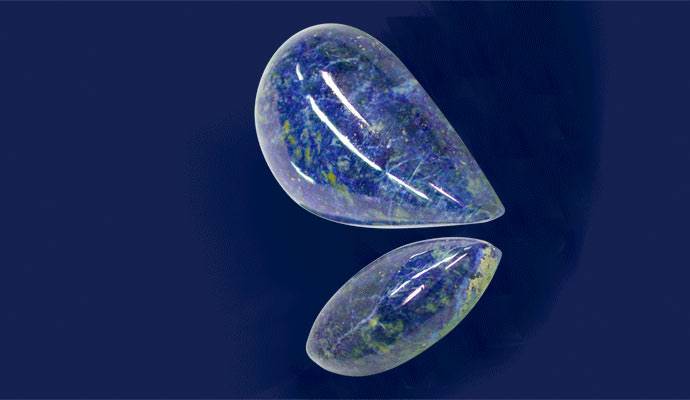|
Gemstones
Articles from GEMSTONES - LOOSE (254 Articles), GEMSTONES - SYNTHETIC (54 Articles), GEMSTONES - CHRYSOPRASE (40 Articles)

Lapis Lazuli
The heavenly hue of Lapis Lazuli
Archaeological evidence has shown that lapis was one of the first stones ever to be worn in jewellery pieces.
Lapis Lazuli is derived from metamorpic rock containing lazurite and other minerals, such as hauynite, sodalite, calcite and pyrites. The pyrites are the cause of the gold-like speckles found in lapis: they are, in fact, iron pyrite crystals. Each of these minerals is classifed as a feldspathoid, produced in place of true feldspar when the silica content of the rock is insufficient.
The best quality lapis lazuli is found in Badakshan, Afghanistan and it was first mined there over 6,000 years ago. Marco Polo visited this location in AD 1271 and from here it was exported into Iraq, Egypt and Europe.
It is the mineral hauynite to which the stone owes its rich colour. Lapis can be discovered in varied shades – from dark blue to green-blue and a deep purple-blue. The most highly sought-after specimen is deep blue with evenly-distributed, fine pyrite flecks. The gold-like iron specs in lapis indicate that the stone is genuine.
The name directly refers to its deep blue hue: lapis lazuli being derived from Latin word ‘lazuris’ meaning blue.
Archaeological evidence has shown that lapis was one of the first stones ever to be worn in jewellery pieces. Excavations of ancient tombs in areas along the Mediterranean uncovered samples of lapis jewellery, namely necklaces and other objects that the deceased were buried with. This indicates that people in Mesopotamia, Egypt, Persia, Greece and Rome had discovered lapis thousands of years prior to anyone else.
Lapis enjoyed another use as the main ingredient in an ‘ultramarine’ paint pigment. The vibrant blue paint was used in numerous works of art throughout the 19th century.
Practical use aside, lapis legends are plentiful. One in particular tells of a medieval priest-king named Prester John who had a bed made from the stone. The lapis bed was said to have the power to rid the priest-king of his lustful thoughts during the night and, thus, to help preserve chastity.
Many people swore by lapis for its healing properties. Ancient Egyptians utilised the stone in a powdered form combined with milk and slime from the Nile (called crocodile earth) in the belief that the concoction would cure cataracts on the eye. Lapis was also considered a sacred stone.
Its dark blue shade reminded many of the heavens and the gold-like specs resembled the stars.
While many of lapis’ healing properties have little credibility in the
western world, some cultures still believe the gem has the power to
heal apoplexy, purify blood, counter depression, eye complaints,
headaches, melancholia, neuralgia and skin disorders.
While lapis is still a favourite for jewellery manufacturers today, one
should remember that it is a relatively soft stone, rating just 5.5 on
Moh’s scale. Therefore it is easily scratched and chipped and should be
treated with a degree of care, particularly when polishing. It should
also be guarded against acid-based substances and excessive sunlight.
fact sheetAugust - Lapis Lazuli
Hardness: 5.5
Variety of: feldspathoid
Found: Afghanistan, Russia, Chile,
USA, Canada, Myanmar, Angola,
Pakistan and Italy.
BirthstonesModern: Peridot
Traditional: Sardonyx
Mystical: Diamond
Ayurvedic: Sapphire
Zodiac birthstones Leo (July 21- August 21) Rock crystal/ onyx
Virgo (August 22- September 22) Carnelian
Posted August 01, 2005
|
|
|
|